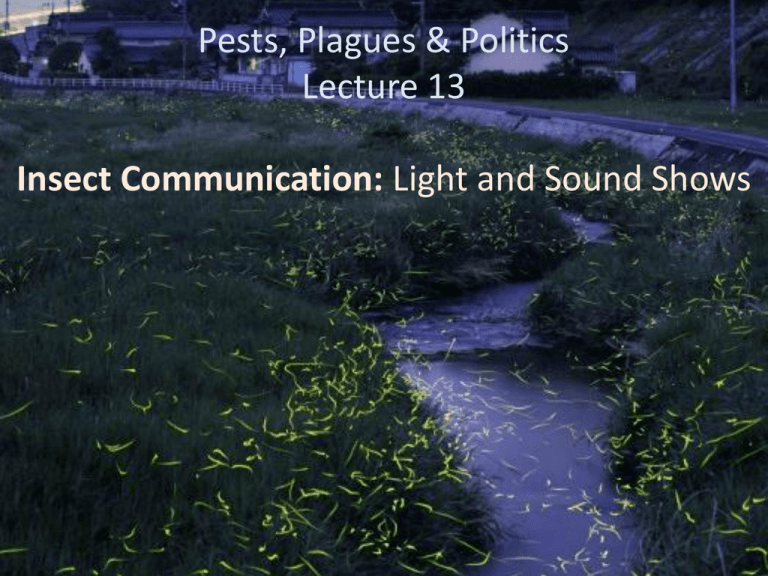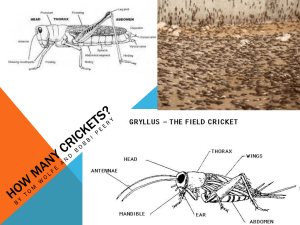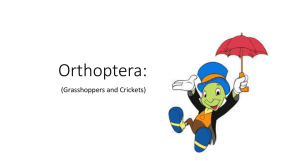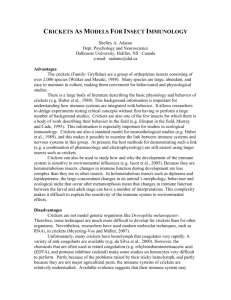Pests, Plagues & Politics
advertisement

Pests, Plagues & Politics Lecture 13 Insect Communication: Light and Sound Shows Key Points: Insect Communication: Light and Sound Shows • Bioluminescence – Which orders use it? – How do they use it? • Sound Communication – Which order is best known for “singing” – Functions of acoustic behavior – Mechanisms for sound production – Temporal separation http://www.youtube.com/watch?v=PnxkCX3tX1Q Communication with LIGHT • Fireflies & Glow-worms • Misnomer – neither Fire, nor are they Flies (well, sometimes they are) • Coleoptera (Beetles) – families • Lampyridae • Phengodidae • Utilize bioluminescence for sexual communication. http://beneficialbugs.org/bugs/Firefly/boreal_firefly.htm Communication with LIGHT • Bioluminescence – Nearly 100% of a firefy’s light is given off as light – Compare this to an incandescent light bulb, which gives off 10% light and 90% heat • The chemical reaction: – Understanding this chemistry led to the making of glowsticks! Fireflies • Wonderful scientific names such as: – Photuris • “tail light” (photos = light - ouron = tail) – Photinus • “a little tail light” (diminutive form) Fireflies • Courtship Signals – Flash patterns are species specific – Normally females (on the ground) signaling for flying males. – Females frequently wingless or even “larviform” as adults. Female Photinus bromleyi The Mating Game Fireflies • Synchronous-Aggregate Flashers – S.E. Asia Glow-Worms • Some are beetles - some are flies – ergo, the confusion of common names. Glow-Worm (a fly) Arachnocampa luminosa - A fungus gnat from New Zealand Glow-Worms Larvae create sticky mucous strings and light them up with their glowing tails to lure and trap other insects! Glow-worm (a beetle) Phengodes sp. larva, Maryland Frequently asked question • Why are there no fireflies in Oregon?? • ANSWER: There ARE fireflies in Oregon! Zarhipis integripennis Pterotus obscuripennis Oregon Glow-worms • Two beetle species in two different families – Zarhipis integripennis (Phengodidae) • a predator of millipedes • light from each body segment – Pterotus obscuripennis (Lampyridae) • a predator of snails • light from terminal body segment – Bioluminescence from embryo-larvalarviform adult females (males do not “glow”) Communication with Sound • “A great many insect species produce sound by means of special structures, but only a few, such as crickets, grasshoppers & cicadas, are heard by most people” – Borror & DeLong • The ORTHOPTERA – others: Coleoptera, Hymenoptera, Isoptera, Homoptera & Lepidoptera Functions of Acoustic Behavior • REPRODUCTION – primarily for mate attraction &/or territorial display (much like birds) • REPELLENCY – Passalid beetles; hissing cockroach, et alia • DEFENSE ALARMS – termites, et alia Functions of Acoustic Behavior • FOOD GATHERING – Phonotaxis by parasitoids & predators – Female flies of the genus Ormia must find a specific cricket host on which to deposit their parasitic maggots. To reproduce, female flies must perform the same task as female crickets - to find a singing male cricket. – has led to the “development” of smart, silent, satellite male crickets. Mechanisms for sound production • STRIDULATION – the rubbing of one body part against another • grasshoppers, beetles, ad infinitum • THE most common insect musical “instrument” • VIBRATION – of special membranes known as TYMBALS • cicadas, some leafhoppers, some moths – of wings or thorax • incidental sounds from many, many species. Chirp Chirp! • Only the males chirp – There are special songs for courtship, fighting and sounding an alarm • Sense sound using tympani (hearing organs) in their front legs • Want to know the temp.? – Chirps/15 sec. + 40. Mechanisms for sound production • STRIKING against a substrate – alarm calls of damp wood termites • EJECTION of air – death head moth, hissing cockroach The most noted “singers” • The Orthopterans – grasshoppers - crickets - katydids – Stridulation is the primary mechanism – Two Song Types • “Calling” songs by males for females • “Fighting” songs by males for territorial defense Temporal Song Separation • Night Singers – nearly all katydids • Day Singers – most grasshoppers • Day &/or Night Singers – most crickets Chorus Singers • Cone-headed grasshoppers & tree crickets – More than two individuals singing simultaneously, with their sound pulses synchronized or alternating. Neoconocephalus retusus Cone headed grasshopper Gryllodes sigillatis Tropical House Cricket Gryllus fultoni Southern Wood Cricket Oecanthus pini Pine Tree Cricket Neoxabea bipunctata Two spotted tree cricket Pictonemobius hubbelli Hubbell’s Ground Cricket Tidewater meadow cricket Conocephalus nigropleuroides Conocephalus fasciatus Slender Meadow Katydid Orchelimum silvaticum Long-spurred Meadow Katydid Orchelimum vulgare Common Meadow Katydid Palmetto Conehead Belocephalus sabalis Key Points: Insect Communication: Light and Sound Shows • Bioluminescence – Which orders use it? – How do they use it? • Sound Communication – Which order is best known for “singing” – Functions of acoustic behavior – Mechanisms for sound production – Temporal separation Cicadas en masse, Princeton, 2004











